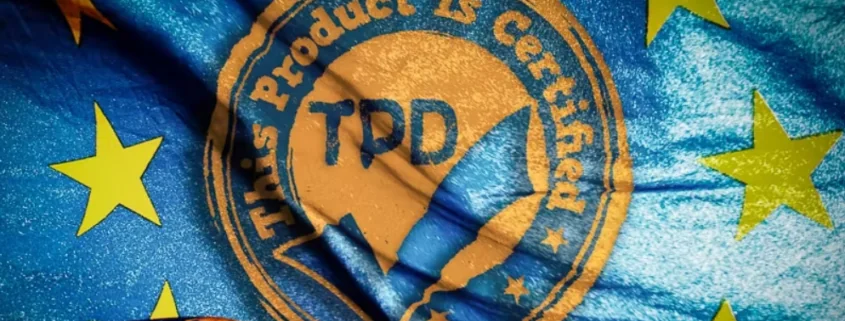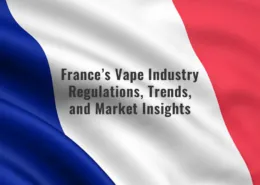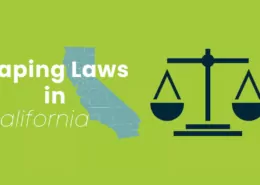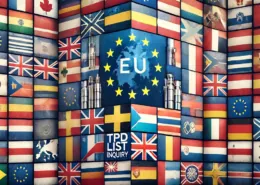Germany Vape & E-liquid TPD Registration Guide (2025)
Germany stands as one of the largest and most significant vape markets in Europe, with an estimated 1.5 million vapers among its adult population as of 2021. This vibrant market presents a substantial opportunity for businesses in the e-cigarette and e-liquid industry. However, accessing this lucrative market requires navigating a complex and stringent regulatory framework. The foundation of these regulations is the European Union’s Tobacco Products Directive (TPD), which has been transposed into German national law. For any business looking to manufacture, import, or sell vaping products in Germany, a thorough understanding of the TPD registration process and ongoing compliance requirements is not just advisable—it’s mandatory. This guide will delve into the specifics of TPD registration in Germany, covering e-liquids and vape devices, taxation, product standards, and advertising restrictions.
Understanding the Tobacco Products Directive (TPD)
The Tobacco Products Directive (Directive 2014/40/EU), which came into force across the EU on May 20, 2016, is the primary piece of legislation governing tobacco and related products. Its scope is extensive, covering traditional items like cigarettes, cigars, and pipe tobacco, as well as novel products, including e-cigarettes, e-liquid refill containers, and heated tobacco products. The TPD’s main objectives are to ensure a high level of health protection for European citizens, facilitate the smooth functioning of the internal market for these products, and meet the obligations of the World Health Organization’s Framework Convention on Tobacco Control.
The TPD imposes significant obligations on manufacturers and importers, establishing a harmonized set of rules across all EU member states. Key provisions that directly impact the vaping industry include:
- Product Notification and Registration: Manufacturers and importers must provide detailed information about their products to the competent authorities of the EU Member States before they can be legally sold.
- Safety and Quality Standards: The directive sets baseline standards for product safety, including limits on nicotine concentration and e-liquid volume, as well as requirements for child-resistant packaging.
- Advertising and Promotion Restrictions: It introduces significant limitations on how e-cigarette products can be marketed, particularly in mass media channels, to prevent youth uptake.
- Laboratory Testing Requirements: The TPD framework necessitates laboratory testing to verify product contents and emissions, ensuring that harmful substances are not present above certain levels or are excluded entirely.
It’s crucial to remember that while the TPD sets the baseline, individual EU member states, including Germany, can and often do implement additional national laws that build upon or further specify these requirements.
The TPD Registration Process in Germany
For any vaping product to be legally sold in Germany, it must be registered through the EU Common Entry Gate (EU-CEG) system. This is the centralized portal used for notifying national authorities about products being placed on the market. The process is meticulous and requires detailed technical information.
What Products Fall Under TPD Registration in Germany?
In Germany, the TPD registration requirements are comprehensive. They apply not only to standard nicotine-containing and nicotine-free e-liquids but also to:
- Shortfills & Longfills: These are larger bottles of nicotine-free e-liquid designed to have a nicotine shot added by the consumer. Even as nicotine-free bases, they fall under the notification requirements.
- CBD E-liquids: Liquids containing cannabidiol (CBD) intended for vaping are also subject to TPD registration.
- E-liquid Flavorings: Concentrated flavorings sold specifically for the purpose of mixing e-liquids must also be notified.
- Vape Devices (Hardware): Electronic cigarettes, vape pens, mods, tanks, and even empty pods and cartridges are covered. Manufacturers must provide technical specifications and safety information for these devices.
It’s important to note a key distinction: nicotine pouches are currently considered a food product in Germany and, therefore, do not fall under the Tobacco Products Directive. They are regulated under different legislation.
The EU-CEG Notification Process:
The registration process via the EU-CEG portal involves several key steps:
- Obtain a Submitter ID: Before you can submit any notifications, your company must register with the EU-CEG system to obtain a unique Submitter ID. This process typically takes a few days.
- Compile Product Dossiers: For each product (both e-liquids and devices), you must compile a detailed technical dossier. This includes:
- A comprehensive list of all ingredients and their quantities.
- Toxicological data for all ingredients.
- Detailed information on the emissions produced when the product is used, which requires laboratory testing.
- A description of the production process, ensuring it meets quality standards.
- Information on nicotine dose and uptake.
- For devices, technical specifications, including battery safety information and details on the atomizer/coil.
- Submit Notifications: The compiled dossiers are submitted through the EU-CEG portal to the relevant German authority, which is the Federal Office for Consumer Protection and Food Safety (BVL). This notification must be completed six months before the product is intended to be placed on the market.
Product and Packaging Requirements in Germany
Beyond registration, all vaping products sold in Germany must adhere to strict TPD-derived standards:
- Nicotine Strength and Volume Limits:
- Maximum nicotine concentration for e-liquids is 20 mg/mL.
- Maximum volume for nicotine-containing e-liquid refill bottles is 10mL.
- Maximum volume for disposable e-cigarettes, tanks, or pods is 2mL.
- Packaging and Labeling:
- All nicotine-containing products must be in child-resistant and tamper-evident packaging.
- Packaging must display a prominent health warning in German, covering 30% of the front and back surfaces. The standard warning is: “Dieses Produkt enthält Nikotin: einen Stoff, der sehr stark abhängig macht.” (This product contains nicotine: a substance that is highly addictive).
- A full list of ingredients must be included on the packaging.
- The nicotine content and delivery per dose must be clearly stated.
- Prohibited Ingredients in E-Liquids: Germany maintains a national list of substances that are forbidden in e-liquids. While the full list is extensive, some examples of prohibited ingredients include:
- Certain amino acids approved for dietetic foods.
- Bitter Almond Oil.
- CMR substances (Carcinogenic, Mutagenic, or Reprotoxic).
- Specific sugars like glucose, fructose, and galactose.
- Ingredients derived from coffee or coffee beans.
- Vitamins used to suggest health benefits (e.g., Vitamin E acetate, which was linked to the EVALI crisis in the US).
- Stimulants like caffeine and taurine.
- L-Carnitine.
This list is subject to change, and manufacturers must stay vigilant about compliance.
Read more:
EU TPD List Inquiry Websites: Comprehensive Guide for Compliance
E-Liquid Fees and Taxation in Germany
A significant operational consideration for any vape business in Germany is taxation. While there are no fees for the TPD registration of e-liquids in Germany itself, the products are subject to a substantial excise tax.
Since July 1, 2022, Germany has implemented a progressive excise tax on all vaping substances, including nicotine-containing and nicotine-free e-liquids, as well as bases like PG and VG if intended for use in e-cigarettes. The tax rate is levied per milliliter of liquid and is scheduled to increase annually:
- Current Rate (2025): €0.26 per milliliter.
- From January 1, 2026: The rate will increase to €0.32 per milliliter, making Germany’s vape tax one of the highest in the European Union.
This excise tax is in addition to the standard 19% Value Added Tax (VAT). All e-liquid products sold in Germany must have a German tax stamp (Steuerbanderole) affixed to the retail packaging, which serves as proof that the excise tax has been paid. Sourcing products from distributors who can provide fully compliant, tax-stamped inventory is essential for retailers.
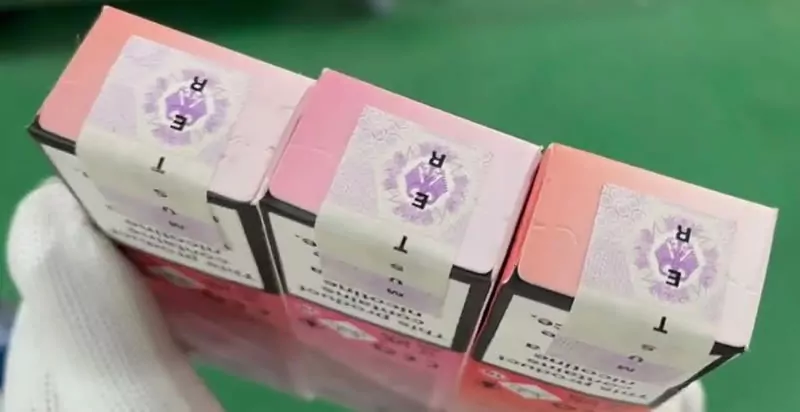
Strict Limited Advertising and Promotion
The TPD, as implemented in Germany, places significant restrictions on the advertising and promotion of e-cigarette products. The goal is to prevent marketing that could appeal to youth or non-smokers. Key restrictions include:
- A ban on advertising in mass media channels such as television, radio, and most print publications (newspapers, magazines).
- Restrictions on online advertising, including on social media platforms.
- A ban on the sponsorship of cross-border events or activities.
While some forms of advertising, such as posters and cinema ads (often restricted to after 6 PM), may be permitted, all promotional materials must be carefully designed to avoid any claims of health benefits or any imagery that could be seen as targeting minors.
Read more:
How to Open a Vape Shop in Germany
Conclusion:
The German vape market, while large and full of opportunity, is governed by a rigorous and multi-layered regulatory system. For any business aiming to succeed, a deep and proactive commitment to compliance is not just a legal necessity but a core business strategy. The TPD registration process through the EU-CEG portal is a mandatory and detailed undertaking that requires careful preparation, including laboratory testing and comprehensive product documentation for both e-liquids and hardware.
Beyond initial registration, ongoing adherence to rules regarding product standards, packaging, labeling, advertising, and the complex excise tax stamp system is crucial. The progressive tax increases and the potential for future regulations on flavors or product types mean that businesses must remain vigilant and adaptable. By prioritizing quality, safety, and full regulatory compliance, manufacturers, importers, and retailers can build a trustworthy brand and successfully operate within one of Europe’s most important vaping markets. If you are in the e-liquid and vape industry, staying abreast of all legal news and regulatory updates is fundamental to your continued success.
- Malaysia Negeri Sembilan Backs Vape Ban, Awaits Clear Laws - August 5, 2025
- Is It Illegal to Vape or Smoke While Driving in Massachusetts? - August 5, 2025
- Austria Plans to Ban Disposable E-Cigarettes - August 5, 2025
